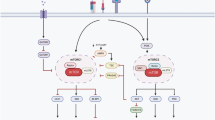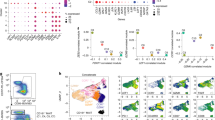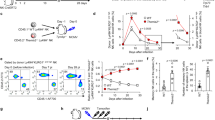Abstract
CD4+ and CD8+ memory T cells are identified into central and effector memory subsets, which are characterized by distinct homing patterns and functions. In this investigation, we show that naïve and central memory CD4+ and CD8+ T cells are sensitive to hydrogen peroxide (H2O2)-induced apoptosis, whereas effector memory CD4+ and CD8+ T cells are relatively resistant to H2O2-induced apoptosis. Apoptosis in naïve and central memory CD4+ and CD8+ is associated with the release of cytochrome c and activation of caspase-9 and caspase-3, upregulation of Bax and voltage-dependent anion channel (VDAC) expression, and decreased intracellular glutathione (GSH). In vitro GSH and a superoxide dismutase mimetic Mn(III) tetrakis (1-methyl-4-pyridyl) porphyrin inhibited H2O2-induced apoptosis in both naïve and central memory CD4+ and CD8+ T cells. Furthermore, VDAC inhibitor 4,4′-diisothiocynostilbene-2,2′-disulfonic acid blocked H2O2-induced apoptosis. These data demonstrate that H2O2 induces apoptosis preferentially in human naïve and central memory CD4+ and CD8+ T cells via the mitochondrial pathway by regulating intracellular GSH and the expression of Bax and VDAC.
This is a preview of subscription content, access via your institution
Access options
Subscribe to this journal
Receive 6 digital issues and online access to articles
$119.00 per year
only $19.83 per issue
Buy this article
- Purchase on Springer Link
- Instant access to full article PDF
Prices may be subject to local taxes which are calculated during checkout









Similar content being viewed by others
References
Kaech SM, Ahmed R . Memory CD8+ T cell differentiation: initial antigen encounter triggers a developmental program in naïve cells. Nat Immunol 2001; 2: 415–422.
Sallusto F, Lenig D, Forster R, Lipp M, Lanzavecchia A . Two subsets of memory T lymphocytes with distinct homing potentials and effector functions. Nature 1999; 401: 708–712.
Masopust D, Vezys V, Marzo AL, Lanzavecchia A . Preferential localization of effector memory cells in nonlymphoid tissue. Science 2001; 291: 2413–2417.
Weninger W, Crowley MA, Manjunath N, von Andriane UH . Migratory properties of naïve, effector, and memory CD8 (+) T cells. J Exp Med 2001; 194: 953–966.
Arbones SL, Ord DC, Ley K, Ratech H, Maynard-Curry C, Otten G et al. Lymphocyte homing and leukocyte rolling and migration are impaired in L-selectin-deficient mice. Immunity 1994; 1: 247–260.
Campbell JJ, Bowman EP, Murphy K, Youngman KR, Siani MA, Thompson DA et al. 6-C-kine (SLC), a lymphocyte adhesion-triggering chemokine expressed by high endothelium, is an agonist for MIP-13β receptor (CCR7). J Biol Chem 1998; 414: 1053–1059.
Gupta S, Bi R, Su K, Yel L, Chiplunkar S, Gollapudi S . Characterization of naïve, central, memory and effector CD8+ T cells: effect of age. Exp Gerontol 2004; 39: 545–550.
Tomiyama H, Matsuda T, Takiguchi M . Differentiation of CD8+ T cells from a memory to memory/effector phenotype. J Immunol 2002; 168: 5538–5550.
Sallusto F, Geginat J, Lanzavecchia A . Central memory and effector memory T cell subsets: function, generation, and maintenance. Ann Rev Immunol 2004; 22: 745–763.
Gupta S, Gollapudi S . Central and effector memory CD4+ and CD8+ T cells display differential sensitivity to TNF-α-induced apoptosis. NY Acad Sci 2005; 1050: 108–115.
Ashkenazi A, Dixit VM . Death receptors: signaling and modulation. Science 1998; 281: 1305–1308.
Krammer PH . CD95's deadly mission in the immune system. Nature 2000; 407: 789–795.
Kroemer G, Reed JC . Mitochondrial control of cell death. Nat Med 2000; 6: 513–519.
Martinou J-C, Green DR . Breaking the mitochondrial barrier. Nat Rev Mol Cell Biol 2001; 2: 63–67.
Ryter SW, Kim HP, Hoetzel A, Park JW, Nakahira K, Wang X et al. Mechanisms of cell death in oxidative stress. Antioxid Redox Signal 2007; 9: 49–89.
Buttke TM, Sandstrom PA . Oxidative stress as mediator of apoptosis. Immunol Today 1994; 15: 5–10.
Cai J, Jones DP . Superoxide in apoptosis. Mitochondrial generation triggered by cytochrome c loss. J Biol Chem 1998; 273: 11401–11404.
Le Bras M, Clement MV, Pervaiz S, Brenner C . Reactive oxygen species and the mitochondrial signaling pathway of cell death. Histol Histopathol 2005; 20: 205–220.
Ratan RR, Murphy TH, Baraban JM . Oxidative stress induces apoptosis in embryonic cortical neurons. J Neurochem 1994; 62: 376–379.
Gupta S, Su H, Bi R, Gollapudi S . Differential sensitivity of naïve and memory CD8+ T cells to TNF-α-induced apoptosis. J Clin Immunol 2006; 26: 193–203.
Gupta S, Gollapudi S . TNF-α-induced apoptosis in human naïve and memory CD8+ T cells in aging. Exp Gerontol 2006; 41: 69–77.
Colombini M . VDAC: the channel at the interface between mitochondria and the cytosol. Mol Cell Biochem 2004; 256/257: 107–115.
Tsujimoto Y, Shimizu S . The voltage-dependent ion channel: an essential player in apoptosis. Biochimie 2002; 84: 187–193.
Shimizu S, Narita M, Tsujimoto Y . Bcl-2 family proteins regulate the release of apoptogenic cytochrome c by the mitochondrial channel VDAC. Nature 1999; 399: 483–487.
Shimizu S, Ide T, Ynagidas T, Tsujimoto Y . Electrophysiological study of a novel large pore formed by Bax and the voltage-dependent anion channel that is permeable to cytochrome c. J Biol Chem 2000; 276: 12321–12325.
Castino R, Bellio N, Nicotra G, Follo C, Trincheri NF, Isidoro C . Cathepsin D-Bax death pathway in oxidative stressed neuroblastoma cells. Free Radic Biol Med 2007; 42: 1305–1316.
Yu BP . Cellular defenses against damage from reactive oxygen species. Physiol Rev 1994; 74: 139–162.
Esteve JM, Mompo J, de la Asuncion G, Sastre J, Aesnsi M, Boix J et al. Oxidative damage to mitochondrial DNA and glutathione oxidation in apoptosis: studies in vivo and in vitro. FASEB J 1999; 13: 1055–1064.
Beaver JP, Waring P . A decrease in intracellular glutathione concentration precedes the onset of apoptosis in murine thymocytes. Eur J Biol 1995; 68: 47–54.
Armstrong JS, Jones DP . Glutathione depletion enforces the mitochondrial permeability transition and causes cell death in Bcl-2 overexpressing HL60 cells. FASEB J 2002; 10: 1263–1265.
Gupta S, Yel L, Chiplunkar S, Kim CH, Kim D, Gollapudi S . Arsenic trioxide induces apoptosis in peripheral T lymphocyte subsets by inducing oxidative stress mitochondrial pathway. A role of Bcl-2. Mol Cancer Ther 2003; 2: 711–719.
Zachwieja J, Zaniew M, Bobkowski W, Stefaniak E, Warzywoda A, Ostalska-Nowicka D et al. Beneficial in vitro effect of N-acetyl-cystein on oxidative stress and apoptosis. Pediatr Nephrol 2005; 20: 725–731.
Sun J, Chen Y, Li M, Ge Z . Role of antioxidant enzymes on ionizing radiation resistance. Free Radic Biol Med 1998; 24: 586–593.
Faulkner KM, Liochev SI, Fridovich I . Stable Mn(III) porphyrins mimic superoxide dismutase in vitro and substitute for it in vivo. J Biol Chem 1994; 69: 23471–23476.
Lee JH, Lee YM, Park J-W . Regulation of ionizing radiation-induced apoptosis by a manganese porphyrin complex. Biochem Biophys Res Commun 2005; 334: 298–305.
Melov S, Schneider JA, Day BJ, Hinerfield D, Coskun P, Mirra SS et al. A novel neurological phenotype in mice lacking mitochondrial manganese superoxide dismutase. Nat Genet 1998; 18: 159–163.
Raha S, Robinson BH . Mitochondria, oxygen free radicals, and ageing. Trends Biochem Sci 2000; 25: 502–508.
Jezek P, Hlavata L . Mitochondria in homeostasis of reactive oxygen species in cells, tissues, and organisms. Int J Biochem Cell Biol 2005; 37: 2478–2503.
Sprent J . Turnover of memory phenotype CD8+ T cells. Microbiol Infect 2003; 5: 227–231.
Geginat J, Lanzavecchia A, Sallusto F . Proliferation and differentiation potential of human CD8+ memory T-cell subsets in response to antigen or homeostatic cytokines. Blood 2003; 101: 4260–4266.
Grayson J M, Harrington LE, Lanier JG, Wherry EJ, Ahmed R . Differential sensitivity of naïve and memory CD8+ T cells to apoptosis in vivo. J Immunol 2002; 169: 3760–3770.
Takahashi A, Hanson MGV, Norell HR, Havelka AM, Kono K, Malmberg K-J et al. Preferential cell death of CD8+ effector memory (CCR7−CD45RA−) T cells by hydrogen peroxide-induced oxidative stress. J Immunol 2005; 174: 6080–6087.
Zamzami N, Kroemer G . Apoptosis: mitochondrial membrane permeabilization—the (w)hole stoty? Curr Biol 2003; 13: R71–R73.
Zoratti M, Szabo I . The mitochondrial permeability transition. Biochim Biophys Acta 1995; 1241: 139–146.
Hodge T, Colombini M . Regulation of metabolite flux through voltage-gating of VDAC channels. J Membr Biol 1997; 157: 271–279.
Dhanasekaran A, Kotamraju S, Karunakaran C, Kalivendi SV, Thomas SJ, Joseph J et al. Mitochondria superoxide dismutase mimetic inhibits peroxide-induced oxidative damage and apoptosis: role of mitochondrial superoxide. Free Radic Biol Med 2005; 39: 567–583.
Sohal RS, Orr W . Role of oxidative stress in senescence. Aging 1998; 10: 149–151.
Fangoni FF, Vescovini R, Passeri G, Bologna G, Padrazzoni M, Lavagetto G et al. Shortage of circulating naïve CD8+ T cells provides new insights on immunodeficiency in aging. Blood 2000; 95: 2860–2868.
Gupta S . Molecular mechanisms of apoptosis in the cells of the immune system in human aging. Immunol Rev 2005; 205: 114–129.
Chikahisa L, Oyama Y, Okazaki E, Noda K . Fluorescent estimation of H2O2-induced changes in cell viability and cellular non protein thiol level of dissociated rat thymocytes. Jpn J Pharmacol 1996; 71: 299–305.
Author information
Authors and Affiliations
Corresponding author
Rights and permissions
About this article
Cite this article
Gupta, S., Young, T., Yel, L. et al. Differential sensitivity of naïve and subsets of memory CD4+ and CD8+ T cells to hydrogen peroxide-induced apoptosis. Genes Immun 8, 560–569 (2007). https://doi.org/10.1038/sj.gene.6364416
Received:
Revised:
Accepted:
Published:
Issue Date:
DOI: https://doi.org/10.1038/sj.gene.6364416
Keywords
This article is cited by
-
Regulation of c-SMAC formation and AKT-mTOR signaling by the TSG101-IFT20 axis in CD4+ T cells
Cellular & Molecular Immunology (2023)
-
Regulated cell death (RCD) in cancer: key pathways and targeted therapies
Signal Transduction and Targeted Therapy (2022)
-
Modulation of the mitochondrial voltage-dependent anion channel (VDAC) by hydrogen peroxide and its recovery by curcumin
European Biophysics Journal (2020)
-
Cell death mechanisms in eukaryotes
Cell Biology and Toxicology (2020)



